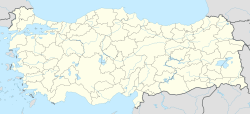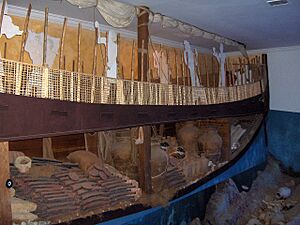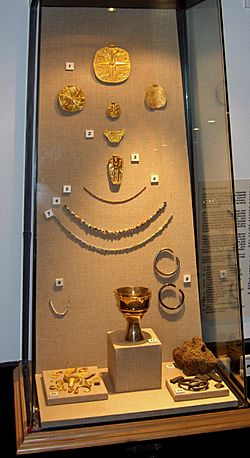Uluburun shipwreck facts for kids
|
Uluburun is Turkish for "Grand Cape"
|
|
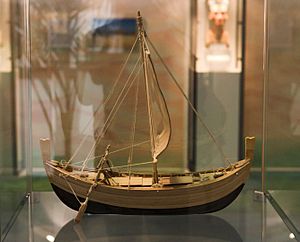
Wooden model of the ship's reconstruction
|
|
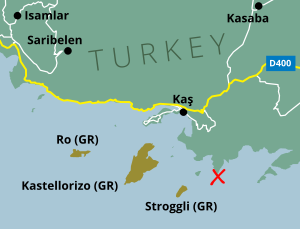 |
|
| Location | Uneven slope of the headland's shelf, 44 m (144 ft) to 52 m (171 ft) deep, with artifacts down to 61 m (200 ft) |
|---|---|
| Region | Bay of Antalya, off the Turquoise Coast. |
| Coordinates | 36°7′43″N 29°41′9″E / 36.12861°N 29.68583°E |
| Type | Site of a sunken ship |
| Length | About 10 m (33 ft) N-S, horizontal plot plan |
| Width | About 18 m (59 ft) E-W, horizontal plot-plan |
| Area | 180 m2 (1,900 sq ft), horizontal plot-plan |
| Height | Depth differential is 8 m (26 ft) vertical, with scattered artifacts, 17 m (56 ft) |
| History | |
| Builder | Unknown. The cargo was probably Mycenaean, deduced from the major type of ingot |
| Material | Wooden, single-mast, two-prow (stem, stern) sailing ship with one steering oar on a side |
| Founded | In use late 14th century BC; date obtained by dendrochronological dating |
| Abandoned | Sank late 14th century BC |
| Periods | Late Bronze Age |
| Cultures | Mycenaean, Cypriote, judging by the pottery |
| Associated with | Crew of the merchant vessel |
| Events | Collision with the headland, perhaps wind-driven |
| Site notes | |
| Excavation dates | Excavational dives directed by George Bass in 1984, and Cemal Pulak in 1985–1994 |
| Archaeologists | George F. Bass, Cemal Pulak |
| Condition | Conservation, sampling and study are ongoing |
| Ownership | Republic of Turkey |
| Management | Institute of Nautical Archaeology, an international organization |
| Public access | Objects may be viewed in the exhibit at the Bodrum Museum of Underwater Archaeology |
The Uluburun Shipwreck is a very old sunken ship from the Late Bronze Age. It sank around the late 14th century BC. This amazing shipwreck was found near Uluburun, which means "Grand Cape" in Turkish. It lies in the Mediterranean Sea, off the coast of Turkey.
A local sponge diver named Mehmed Çakir discovered the wreck in the summer of 1982. He was from a village called Yalıkavak, near Bodrum. After its discovery, archaeologists spent ten years, from 1984 to 1994, exploring the site. They made over 22,000 dives! This helped them find one of the most incredible collections of items from the Late Bronze Age ever found in the Mediterranean.
Contents
How the Shipwreck Was Found
The Uluburun shipwreck was found in 1982. Mehmet Çakir, the sponge diver, saw some strange "metal biscuits with ears." He recognized them as oxhide ingots. These were large pieces of metal shaped like animal hides.
Turkish sponge divers often helped the Institute of Nautical Archaeology (INA) find ancient wrecks. Çakir's discovery led Oğuz Alpözen, who directed the Bodrum Museum of Underwater Archaeology, to send a team. This team, made up of museum and INA archaeologists, found many copper ingots. They were only about 50 meters from the Uluburun shore.
Where the Ship Was Going
Archaeologists can guess where the ship came from and where it was headed by looking at its cargo. The ship likely started its journey from a port in Cyprus or the Syria-Palestine area.
It was definitely sailing west of Cyprus. Experts believe its final stop was somewhere in the Aegean Sea. Rhodes, an important trading hub back then, is one possible destination. The people who excavated the ship think it was probably going to one of the Mycenaean palaces in mainland Greece.
How Old Is the Ship?
Scientists used different methods to figure out when the Uluburun ship sank. One method is called dendrochronology. This is like counting tree rings.
A piece of wood from the ship showed tree rings from as late as 1305 BC. Since the bark was gone, it's hard to know if there were younger rings. But it's thought the ship sank soon after this date. Another study using Radiocarbon dating on plant materials suggested the ship sank around 1320 BC.
A gold scarab (a beetle-shaped charm) found on the ship also helped with dating. It had the name of Nefertiti, an Egyptian queen. This means the ship could not have sunk before her time. So, most experts agree the ship sank at the end of the 14th century BC.
The items on the ship came from many different places. They were from northern Europe to Africa, and from Sicily in the west to Mesopotamia in the east. This shows that people traded across a huge area during the Late Bronze Age. It was like a busy international trade network.
The Ship Itself
The Uluburun ship was about 15 to 16 meters (around 50 feet) long. It was built using a special method called "shell-first." This means the outer shell of the ship was built first.
The ship's planks and a basic keel (the main beam along the bottom) were made from Lebanese cedar and oak. Lebanese cedar trees grow in places like Lebanon, southern Turkey, and central Cyprus.
The ship carried 24 heavy stone anchors. The type of stone used for these anchors is rare in the Aegean Sea. However, it is often found in ancient temples in Syria-Palestine and on Cyprus. The crew used brushwood and sticks to protect the ship's wooden planks. This padding kept the heavy metal ingots and other cargo from damaging the hull.
Amazing Cargo Found
The Uluburun ship's cargo was mostly raw materials used for trade. Before this ship was found, we only knew about these items from old writings or Egyptian tomb paintings. The cargo matches many royal gifts mentioned in ancient letters found in El-Amarna, Egypt.
Copper and Tin Ingots
- The ship carried ten tons of raw copper. This included 354 large, rectangular pieces called oxhide ingots. They had handholds on each corner.
- Some unique ingots had two handles. These were likely shaped to make it easier to load them onto animals for transport.
- There were also 121 smaller copper ingots, shaped like buns or ovals.
- Most of the copper came from Cyprus.
- The ship also carried about one ton of tin. When mixed with the copper, this would make about 11 tons of bronze.
- Some tin came from a mine in Uzbekistan. Other tin might have come from a mine in Turkey.
Canaanite Jars and Pistacia Resin
- Archaeologists found at least 149 Canaanite jars. These jars were common in Greece, Cyprus, Syria-Palestine, and Egypt.
- Most of these jars contained a sticky substance called Pistacia (terebinth) resin. This was an ancient type of turpentine.
- One jar was filled with glass beads, and many others held olives.
Glass Ingots
- About 175 glass ingots were found. They were cobalt blue, turquoise, and lavender. These are the earliest complete glass ingots ever discovered.
- The blue glass ingots have the same chemical makeup as Egyptian glass items from that time. This suggests they all came from the same place.
Other Cool Items
- Logs of African blackwood, which Egyptians called ebony.
- Ivory from hippopotamus and elephant tusks.
- More than a dozen hippopotamus teeth.
- Tortoise carapaces (upper shells).
- Ostrich eggshells.
- Pottery and oil lamps from Cyprus.
- Bronze and copper bowls.
- Four drinking cups shaped like rams’ heads and one shaped like a woman's head.
- Two duck-shaped ivory cosmetics boxes.
- An ivory cosmetics spoon.
- A trumpet.
- Over two dozen sea-shell rings.
- Beads made of amber (from the Baltic Sea), agate, carnelian, quartz, gold, faience, and glass.
Jewelry, Gold, and Silver
- A collection of gold and silver jewelry from Canaan.
- There were 37 gold pieces, including necklaces, medallions, pendants, and beads.
- The largest gold item was a two-part chalice (a fancy cup).
- Egyptian gold, electrum, silver, and steatite (soap stone) objects were also found.
- A special gold scarab with the name of Queen Nefertiti was on board.
- A bronze female figurine was found, with gold covering her head, neck, hands, and feet.
Weapons and Tools
- Many weapons like arrowheads, spearheads, maces, and daggers.
- A special axe from the Near East.
- Four swords of different types (Canaanite, Mycenaean, and Italian).
- A large number of tools: sickles, awls, drill bits, a saw, tongs, chisels, a ploughshare, whetstones, and adzes.
- A ceremonial axe made of green volcanic stone, likely from Bulgaria.
- A small, folding wooden writing-tablet with ivory hinges. It probably had wax surfaces for writing.
Weights and Measures
- 19 animal-shaped weights.
- 120 geometric-shaped weights. These weights are one of the biggest and most complete sets from the Late Bronze Age.
Food Items
- Almonds
- Pine nuts
- Figs
- Olives
- Grapes
- Safflower
- Black cumin
- Sumac
- Coriander
- Pomegranates
- A few grains of charred Wheat and Barley
Exploring the Wreck Site
The Institute of Nautical Archaeology (INA) started exploring the Uluburun wreck in July 1984. George F. Bass led the first year. Then, Cemal Pulak took over and directed the dives from 1985 to 1994. The wreck was found between 44 and 52 meters (about 144 to 170 feet) deep. It lay on a steep, rocky slope with sandy spots.
Half of the team lived in a camp built on the nearby headland. The other half stayed on the Virazon, INA's research ship. Divers used an underwater telephone booth to talk to the surface. They also used air-lifts to bring up artifacts. The site was mapped using special measuring tools and metal squares to help divers know where they were.
Since the excavation finished in 1994, all the recovered items have been carefully preserved. They are studied and sampled at the Bodrum Museum of Underwater Archaeology in Turkey. You can see many of these amazing objects on display there.
See also
 In Spanish: Pecio de Uluburun para niños
In Spanish: Pecio de Uluburun para niños


